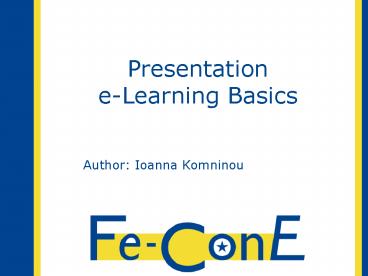Presentation eLearning Basics - PowerPoint PPT Presentation
1 / 10
Title:
Presentation eLearning Basics
Description:
Behaviourism: the focus is on the results of learning, not the process itself. A strong element of behaviourism is positive and negative feedback, which can ... – PowerPoint PPT presentation
Number of Views:22
Avg rating:3.0/5.0
Title: Presentation eLearning Basics
1
Presentation e-Learning Basics
- Author Ioanna Komninou
2
1. History of e-Learning
- Modern distance education has been around at
least since Isaac Pitman taught shorthand in
Great Britain via correspondence in the 1840s (he
was sending assignments to his students by mail
and they completed the 'homework' and sent it
back to him). - In the early 1920s Sidney Pressey developed a
machine to provide drill and practice items to
students in his introductory courses. - The World War II created an enormous
instructional problem - thousands of new recruits
had to be trained rapidly, so the new media
technology became dominant and widely used. The
war was the 'business driver'. - During the 50s Skinner presented the content in
small, related chunks of information. Skinners
Programmed Instruction was very popular and at
this very moment, programmed instruction is
popular when it comes to (digital) self study
courses.
Note Please add some key points of the history
of e-Learning in the field up here
History of e-Learning slide 1 of 2
3
1. History of e-Learning
- The introduction of the first personal computer
(the Altair 880 in 1975) was quickly followed by
the Apple II and the IBM PC. With the Apple and
the IBM the computer was reliable enough and was
used for didactical purposes. - At the end of the 90s the learning management
systems (LMS) were used. Some universities
started to design and develop their own systems
but most of the educational institutions started
with systems off the market.One of the key
players within the educational market was the
American company Blackboard. This was the first
moment that teachers were accepting and using
technology within their own classrooms on a large
base! - In October 1999, during a CBT Systems seminar in
Los Angeles, a strange new word was used for the
first time in a professional environment
e-Learning.
Note Please add some key points of the history
of e-Learning in the field up here
History of e-Learning slide 2 of 2
4
2. Characteristics of e-Learning
- Blended learning a combination of the most
appropriate learning didactical formats, services
and media formats. - You can mix the following things
- offline and online activities
- synchronous and asynchronous activities
- different multi media assets
- different didactical interactions
- different ways of delivering the content
- selfstudy and collaborative learning
- formal and informal learning.
Note Please add some characteristics of
e-Learning in the field up here
Characteristics of e-Learning slide 1 of 2
5
2. Characteristics of e-Learning
- Multimedia several representation forms, not
only different in appearance but they also serve
different didactical/educational characteristics.
- Different formats or representation forms
- Text
- Pictures
- Animations
- Audio
- Video
- Delivery Content can be delivered by many
different means. - Delivery tool Web browser, PDA, Paper, Mobile
phone, iPod, PlayStation, Portable
Note Please add some characteristics of
e-Learning in the field up here
Characteristics of e-Learning slide 2 of 2
6
3. Didactical models
- We can distinguish 3 main models
Behaviourism. Cognitivism. Constructivism. - Behaviourism the focus is on the results of
learning, not the process itself. A strong
element of behaviourism is positive and negative
feedback, which can condition the learner
(reinforcement). A result of this attitude of
learning is the de-contextualizing of learning
content.
Note Please add some notes about didactical
models related to e-Learning in the field
up here
Didactical models slide 1 of 2
7
3. Didactical models
- Cognitivism The focus is on the way we are
learning, not only at the outcome of the learning
process. Techniques like mind mapping are used to
anchor the information. Techniques like mind
mapping are used to anchor the information. - Constructivism Learners construct new ideas,
structures, models and concepts and connect them
to their prior knowledge and mental models. These
instructional experiences must be structured so
that learners can easily adapt the information.
The learner plays an active role and learning is
goal-oriented.
Note Please add some notes about didactical
models related to e-Learning in the field
up here
Didactical models slide 2 of 2
8
4. Ideas about use of e-Learning
Note Please write down your ideas about how to
(further) successfully integrate e-Learning in
your organization in the field up here
Ideas about use of e-Learning slide 1 of 2
9
4. Ideas about use of e-Learning
Note Please write down your ideas about how to
(further) successfully integrate e-Learning in
your organization in the field up here
Ideas about use of e-Learning slide 2 of 2
10
- INSTRUCTIONS FOR SAVING UPLOADING
- YOUR PRESENTATION
- FIRST MAKE SURE YOU SAVE THIS PRESENTATION AT
YOUR LOCAL DRIVE OF YOUR COMPUTER - AFTER YOU HAVE SAVED YOUR PRESENTATION,
- PLEASE ADD YOUR PRESENTATION BY UPLOADING THIS
AT THE PREPARE E-LEARNING PRESENTATION ASSIGNMENT
SUCCESs! The Fe-ConE team

